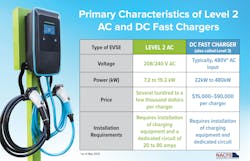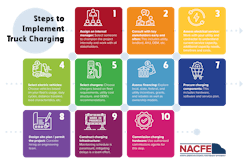Planning electrification could take fleets years, report finds
Even if your fleet doesn’t plan to start folding in electric trucks to its operations this decade, it’s not too early to start considering the future, according to a new guidance report on commercial fleet charging infrastructure.
As the North American Council for Freight Efficiency prepares to study how larger fleets scale up and deploy battery-electric trucks into fleet operations, the council and partner RMI released an updated guidance report on fleet charging infrastructure.
“The more information we have from the customers on what their five- to 10- to 15-year electrification plans are, the more equipped that utility is to have those proactive conversations and try to make good EV rates and good legislative initiatives,” Jennifer Deaton, manager of corporate strategy and electrification for Oncor, told NACFE’s study team.
See also: NACFE sets out to study how fleet depots are scaling up EV adoption
The Charging Forward with Electric Trucks report focuses on charging considerations for commercial EVs currently in production for freight delivery. Charging infrastructure includes not only the chargers themselves but the interrelated system of vehicles, duty cycles, chargers, and electric utilities.
“While there are a great many factors that impact the scaling of electric vehicles for hauling freight, careful planning and collaboration will help make the process go more smoothly,” said Mike Roeth, NACFE’s executive director. “The guidance in this report should give fleets confidence to move forward with adding more electric vehicles to their operations.
Commercial EV interest is surging
This second-generation report on charging infrastructure comes out just months before NACFE begins its Run on Less: Electric Depot, focusing on several fleets running more than a dozen EVs out of the same depot.
This updated report is based on a 2019 NACFE study, Amping Up: Charging Infrastructure for Electric Trucks. The commercial vehicle electrification movement has surged in the four years since that first charging report. But charging electric trucks—which require larger batteries and more power than passenger EVs—is a complex process, the study notes.
See also: Long-haul's journey to near-zero
To help simplify the transition from traditional powertrains, NACFE lays out 10 steps to help fleets successfully implement EV charging infrastructure.
“This step-by-step guide allows fleets to see at a glance the factors they need to focus on as they add more battery-electric vehicles,” said Rob Graff, NACFE’s senior technical adviser. “We expect this to be an invaluable resource for fleets just as the charging procurement roadmap from our first infrastructure report was.”
NACFE’s study team developed six conclusions.
- Electric trucks and chargers must work together. Charging infrastructure is just one part of a system integrating your vehicle needs, electricity rate structure, and the timing and cost of bringing additional electricity to your site.
- Your utility is a key partner. Electric trucks use a lot of power, probably more than you currently have. You must meet in person with your utility as soon as you begin thinking about electric trucks, as they will be your partner in providing the power you need. Increasing power delivery to your facility can take time. Coordinate closely with your utility and modify your implementation schedule to ensure you have power when needed.
- Use and design significantly affect charging costs. In general, spreading charging over the longest time and using lower charging power lowers the charging equipment and electricity costs and maximizes battery life. Design your charging strategy to make the best use of vehicles’ scheduled downtime.
- The transition requires staff and attention. The transition to BEVs and associated charging infrastructure requires attention and expertise. You need to have a single point of contact with internal and external authority and to lead the project.
- Consider other charging business models. You may wish to explore options other than owning and operating your own charging infrastructure as a stopgap or long-term model. These include Charging as a Service (CaaS) and Trucking as a Service (TaaS). CaaS provides a contracted service for all your charging, either on your site or at a nearby shared location.
- Other key considerations. There are a host of other factors to consider when it comes to EV infrastructure as well as other developments to know:
- Grants, incentives, and subsidies are at a historic high, offering a window of opportunity for fleet electrification.
- If you do not own your facility, talk with your landlord early.
- Microgrids are emerging from the shadows.
- The reliability and interoperability of chargers must improve.
- Training a skilled workforce to support and service BEVs and charging hardware is critically important.
- Processes to improve electricity transmission/distribution infrastructure must be improved.
- BEV makers must increase miles per kilowatt, reduce vehicle costs and weight, and increase payload and reliability.
The NACFE report is free to download.
About the Author
Josh Fisher
Editor-in-Chief
Editor-in-Chief Josh Fisher has been with FleetOwner since 2017. He covers everything from modern fleet management to operational efficiency, artificial intelligence, autonomous trucking, alternative fuels and powertrains, regulations, and emerging transportation technology. Based in Maryland, he writes the Lane Shift Ahead column about the changing North American transportation landscape.




